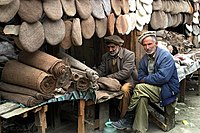পাকোল



পাকোল বা পাকুল (কোওয়ার ও শিনা ভাষায়:پاکول, পশতু: پکول, উর্দু: پاکول) হল একটি নরম, সমতল, গোটান, গোলাকার শীর্ষযুক্ত পুরুষদের টুপি, যা সাধারণত আফগানিস্তান এবং পাকিস্তানে পরা হয়। এটি সাধারণত উল দিয়ে তৈরি এবং বিভিন্ন মাটির রঙে পাওয়া যায়, যেমন বাদামী, কালো, ধূসর, সাদা। আখরোট ব্যবহার করে একে রঙ্গিন লালও করা হয়। পাকোলের উৎপত্তি চিত্রাল,[১][২][৩] বা পাকিস্তানের গিলগিত-বালতিস্তানে বলে মনে করা হয়।[৪][৫]
বর্ণনা
[সম্পাদনা]এটি একটি হাতে বোনা উলের টুপি, যেটি একটি চ্যাপ্টা গোলাকার শীর্ষ দিয়ে গঠিত, নিম্নভাগে গোলাকার ধারি এটিকে ঘিরে রেখেছে। এটি সাধারণত সাদা, ধূসর বা বাদামী রঙের বিভিন্ন পরতে পাওয়া যায়। টুপির ব্যবহারিক নকশা ঠান্ডা আবহাওয়ায় কান ও ঘাড় ঢেকে রাখে এবং উষ্ণ তাপমাত্রায় এটিকে গুটিয়ে নেওয়ার সুযোগ আছে। টুপিটি অনেক উপায়ে সাজানো যায়, কখনও কখনও টুপিতে ফুল বা পালক রাখা হয়, বিশেষ করে উৎসব অনুষ্ঠানের ক্ষেত্রে তা করা হয়। বেসের চারপাশে সেলাই করা একটি দড়ি এর ব্যবহারে অভিযোজ্যতা এবং নমনীয়তা প্রদান করে। দড়িটি শক্ত করে বা আলগা করে, পরিধানকারী প্রয়োজন অনুসারে টুপিটিকে সুরক্ষিত করতে সক্ষম হয়।[৬]
উৎপত্তি ও ইতিহাস
[সম্পাদনা]পাকোলের উৎপত্তি চিত্রালে,[১][২][৩] বা আরও সুনির্দিষ্টভাবে গিলগিত, আস্তোর এবং পাকিস্তানের গিলগিত-বালতিস্তানের আশেপাশের এলাকায়।[৪][৫] পশমী টুপি শতাব্দী ধরে শিনা সম্প্রদায়[৫] [৪] এবং খো জাতির (চিত্রালী নামেও পরিচিত) প্রধান পাগড়ি ছিল।[৩] [১] এটি ১৮৯০ এর দশকের শেষের দিক থেকে আফগানিস্তানের বিভিন্ন সম্প্রদায় যেমন পশতুন, তাজিক এবং নুরিস্তানি দ্বারা গৃহীত হয়েছিল।[৭][৮][৯] এটি পাকিস্তানের পশতুনদের মধ্যে বড় পাগড়ির প্রতিস্থাপন হিসাবে প্রথম গৃহীত হয়েছিল, বিশেষ করে পেশোয়ারের মতো প্রধান শহরগুলিতে।[১০] গ্রামের ব্যবসায়ীদের চিত্রালি টুপির জনপ্রিয়তা ছড়িয়ে দেওয়াতে ভূমিকা ছিল। প্রাথমিকভাবে তারা ব্যবসা সম্প্রসারণ করেছিল এবং শেষে পেশোয়ারের পুরানো শহরের একটি বিশাল এলাকায় তারা আধিপত্য বিস্তার করেছিল, অঞ্চলটি কিসা কাহওয়ানি নামে পরিচিত।[১১] শুধুমাত্র আফগান সীমান্তের উপজাতীয় এলাকায় ঐতিহ্যবাহী পশতুন পাগড়ি তখনও জনপ্রিয় ছিল।[১০] তবে অল্প দিন আগের পেশোয়ারের ছবিতে এখনও দেখা যায় পাকোলের পরিবর্তে পাগড়ি দিয়ে মাথা ঢেকে রাখা মানুষের আধিপত্য।[১০]
সম্প্রতি, কাশ্মীর উপত্যকায় উত্তর কাশ্মীরের বান্দিপুর জেলার গুরেজ এবং তুলেইল এলাকার জাতিগত শিন মরশুমি অভিবাসীরাও পাকোল চালু করেছিল।[১২] বর্তমানে পাকিস্তান এবং আফগানিস্তানের পাশাপাশি ভারতের কিছু অংশ, যেমন জম্মু ও কাশ্মীর এবং দিল্লির সমস্ত সামাজিক শ্রেণি এবং অবস্থানের লোকেরা সাধারণত পাকোল পরিধান করে।[১২][১৩][১৪]
তথ্যসূত্র
[সম্পাদনা]- ↑ ক খ গ Chico, Beverly (২০১৩-১০-০৩)। Hats and Headwear around the World: A Cultural Encyclopedia: A Cultural Encyclopedia। ABC-CLIO। পৃষ্ঠা 367। আইএসবিএন 978-1-61069-063-8।
- ↑ ক খ "From Alexander the Great to Ahmad Shah Massoud: A Social History of the Pakol | Afghanistan Analysts Network"। ৩ জানুয়ারি ২০১৪। সংগ্রহের তারিখ ২০২০-০২-২০।
Finally, Chitral’s claim to the original ownership of the pakol is also supported by the fact that the place used to be at the center of the pakol‘s early “range of distribution”, which at the beginning of the 20th century encompassed mainly Northern Swat, Gilgit, Hunza, and Nuristan.
- ↑ ক খ গ "Grammar and vocabulary of the K̲h̲owâr dialect (Chitrâli)"। digital.soas.ac.uk। ১৮৯৫। পৃষ্ঠা 8।
The dress worn by most men consists of a black, brown, or grey homespun cap made in the shape of a bag and rolled up until it fits the skull.
- ↑ ক খ গ Vogelsang, Willem (২০০৬)। "The Pakol: A Distinctive, but Apparently not so Very Old Headgear from the Indo-Iranian Borderlands": 149–155। ডিওআই:10.2143/KH.2.0.2021290।
- ↑ ক খ গ Biddulph, John (১৮৮০)। Tribes of the Hindoo Koosh। Office of the superintendent of government printing। পৃষ্ঠা 74।
- ↑ Chico, Beverly (২০১৩-১০-০৩)। Hats and Headwear around the World: A Cultural Encyclopedia: A Cultural Encyclopedia। ABC-CLIO। পৃষ্ঠা 367। আইএসবিএন 978-1-61069-063-8।
- ↑ Vogelsang, Willem (২০০৬)। "The Pakol: A Distinctive, but Apparently not so Very Old Headgear from the Indo-Iranian Borderlands": 149–155। ডিওআই:10.2143/KH.2.0.2021290।
- ↑ "From Alexander the Great to Ahmad Shah Massud: A social history of the pakol"। Afghanistan Analysts Network - English (পাশতু ভাষায়)। ২০১৪-০১-০৩। সংগ্রহের তারিখ ২০২২-০৩-১৪।
According to the first proto-ethnographic accounts, the Kafirs – as the Nuristanis were known before their conversion to Islam in 1895-96 – used to go about with their heads generally uncovered. John Biddulph, in 1878, has them avoiding any headgear at all (at least the men).
- ↑ Vogelsang, Willem (২০০৬)। "The Pakol: A Distinctive, but Apparently not so Very Old Headgear from the Indo-Iranian Borderlands": 153–154। ডিওআই:10.2143/KH.2.0.2021290।
- ↑ ক খ গ Vogelsang, Willem (২০০৬)। "The Pakol: A Distinctive, but Apparently not so Very Old Headgear from the Indo-Iranian Borderlands": 149–155। ডিওআই:10.2143/KH.2.0.2021290।
- ↑ Ferrari, Fabrizio (২০১১)। Health and Religious Rituals in South Asia: Disease, Possession and Healing। Taylor & Francis। পৃষ্ঠা 40। আইএসবিএন 978-1-136-84629-8।
- ↑ ক খ Naqash, Rayan (১১ মার্চ ২০১৭)। "Kashmir's stylish and aspirational caps come at a hefty price"। Scroll.in। সংগ্রহের তারিখ ৫ জুলাই ২০২১।
- ↑ Saxena, Shivam (৪ মার্চ ২০১৫)। "Inside Delhi's lil Afghanistan: Aroma of Kabuli pulao, murmurs in Dari"। Hindustan Times। সংগ্রহের তারিখ ১৬ মার্চ ২০১৮।
Several shops run by Afghani refugees at Sharif Manzil now have flourishing businesses of imported carpets, pakol and karakuli caps (below), shawls and vasket (jackets). “We import these caps from Kabul. They are now becoming popular in India too,” says Sikander Khan, who runs a small garment shop in the area.
- ↑ "Pakistan wears many hats, literally"। Aajentertainment.tv। ২০২২-০২-২৪।
